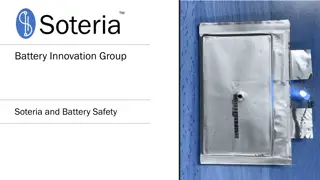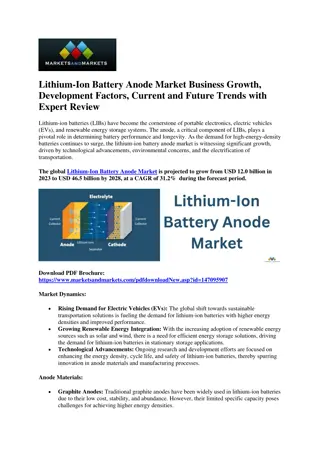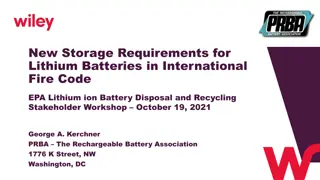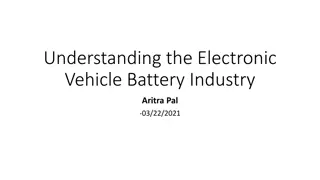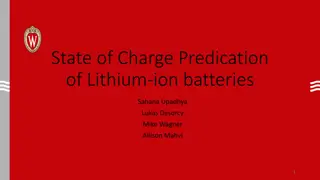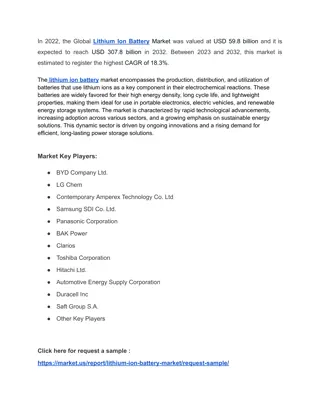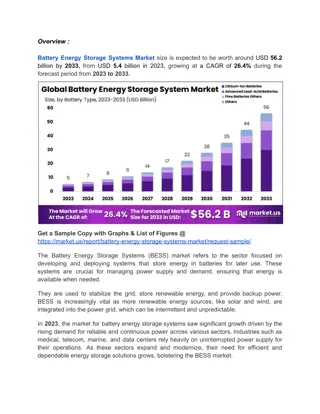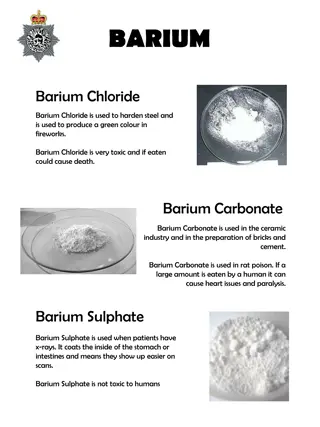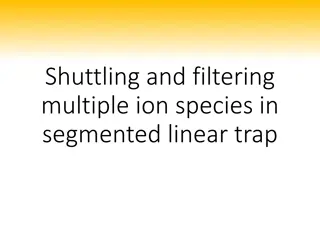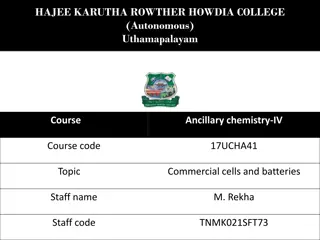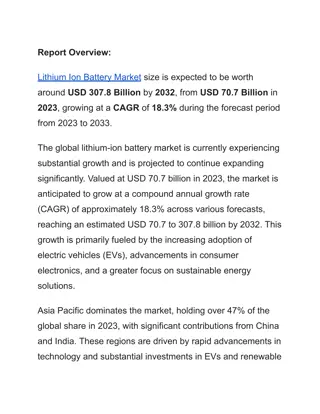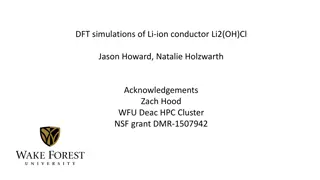Lithium-ion Battery Market
The global lithium-ion battery market size was valued at $46.2 billion in 2022, and lithium-ion battery industry is projected to reach $189.4 billion by 2032, growing at a CAGR of 15.2% from 2023 to 2032.
5 views • 6 slides
Battery technologies: 2. Cell chemistry
Explore the workings of simple electrical cells, their components, and the conversion of chemical energy into electrical energy. Learn about different cell types, primary vs. secondary cells, and the process of recharging. Discover examples of cells like Alkaline, Zinc, NiCad, NiMH, and Lithium-ion,
1 views • 14 slides
Revolutionary Lithium Extraction Technology by SORCIA/IBAT
SORCIA/IBAT's innovative lithium extraction process eliminates the need for chemicals, ensuring efficiency, resource protection, and cost-effectiveness. The modular and mobile plant design allows for rapid deployment with high flexibility, making it a game-changer in the industry. This breakthrough
0 views • 8 slides
Lithium-ion Battery Fire Risks and Safety Measures
Lithium-ion batteries pose significant fire hazards due to factors like flammable materials, manufacturing defects, and charging accidents. The frequent incidents of battery fires in various industries highlight the pressing need for improved safety measures. Current solutions, though existing, are
1 views • 12 slides
Lithium Battery Safety Course Overview
This course aims to educate workers and community members on the potential hazards associated with lithium batteries, safe handling practices, and emergency procedures. Covering topics such as identifying devices that use lithium batteries, understanding risks, implementing safe practices, and outli
1 views • 30 slides
Chronic Myeloid Leukemia
Chronic myeloid leukemia (CML), or chronic myelogenous leukemia, is a slow-growing form of cancer that affects the bone marrow and blood. Like acute myeloid leukemia, CML originates in the myeloid cells. When functioning properly, myeloid cells produce mature red blood cells, platelets and non-lymph
2 views • 7 slides
Lithium-Ion Battery Anode Market Analysis Competitive Landscape & Growth Factors
Europe stands out as the world's number two consumer of lithium-ion battery anodes by value. This robust market is fueled by the growing demand for electric vehicles (EVs) within the region. Government incentives and funding play a crucial role in promoting EV adoption, which in turn, translates to
1 views • 4 slides
Understanding Electricity and Circuits: Components, Cells, Batteries, and Ratings
Explore the fundamentals of electricity and circuits, including circuit components, cells, batteries, types of cells, primary vs. secondary cells, dry vs. wet cells, and ratings. Learn about the relevance of this knowledge in engineering and certifications like NABCEP PV Associate. Discover the work
1 views • 18 slides
Introduction-to-Lithium-Batteries
We have access to higher lithium batteries for solar applications. We manufacture lithium-ion solar batteries, used in inverter batteries and electric automobiles\nWe have access to higher lithium batteries for solar applications. We manufacture lithium-ion solar batteries, used in inverter batterie
0 views • 8 slides
Lithium-Ion Battery Anode Market Size, Share, Industry Analysis and Segments
The global Lithium-Ion Battery Anode Market is projected to grow from USD 12.0 billion in 2023 to USD 46.5 billion by 2028, at a CAGR of 31.2% during the forecast period. The lithium-ion battery anode market is experiencing significant growth driven by the increase in demand for EVs, consumer elect
1 views • 5 slides
Understanding Resting Membrane Potential and Excitability in Cells
Explore the concepts of resting membrane potential (RMP), excitability in cells, and the electrochemical basis behind them. Learn about the characteristics of excitable and non-excitable tissues, the factors influencing RMP, and the role of ion distribution in generating the negative charge inside c
0 views • 15 slides
New Storage Requirements for Lithium Batteries in International Fire Code
The International Fire Code (IFC) is being amended to include new storage requirements for lithium batteries due to their high hazard classification. The upcoming 2024 IFC will introduce stricter guidelines for storing lithium batteries, with limitations on indoor and outdoor storage, permit require
0 views • 14 slides
Understanding the Electronic Vehicle Battery Industry
Exploring the electronic vehicle battery industry, this content delves into the manufacturing processes, cost breakdown, challenges, and areas for cost improvement. Key components like lithium-ion cells, raw material costs, and critical materials such as lithium, cobalt, and nickel are discussed. Th
0 views • 10 slides
Understanding State of Charge Prediction in Lithium-ion Batteries
Explore the significance of State of Charge (SOC) prediction in lithium-ion batteries, focusing on battery degradation models, voltage characteristics, accurate SOC estimation, SOC prediction methodologies, and testing equipment like Digatron Lithium Cell Tester. The content delves into SOC manageme
0 views • 32 slides
Lithium-Ion Battery Market: How Environmental Regulations are Influencing Demand
In 2022, the Global Lithium Ion Battery Market was valued at USD 59.8 billion and it is expected to reach USD 307.8 billion in 2032. Between 2023 and 2032, this market is estimated to register the highest CAGR of 18.3%.\n\nClick here for request a sa
1 views • 4 slides
Understanding Blood Cells and Transport Mechanisms
Your blood, consisting of red blood cells, white blood cells, platelets, and plasma, plays a crucial role in transporting substances like oxygen, nutrients, and waste products throughout your body. Red blood cells are specialized for oxygen transport due to their unique adaptations, while white bloo
2 views • 18 slides
Lithium-Ion Batteries Dominate BESS Market with 53.3% Revenue Share Amid Cost Re
Battery Energy Storage Systems Market By Battery Type(Lithium-Ion Battery, Lead Acid Battery, Flywheel Battery, Other Battery Types), By Connection Type(On-grid, Off-grid), By Ownership (Customer-Owned, Third-Party Owned, Utility-Owned), By Energy Capacity(Below 100 MWh, Between 100 to 500 MWh, Abov
0 views • 4 slides
Chemical Compounds Overview: Barium, Calcium, Sodium, Lithium
Learn about the uses and potential dangers of Barium Chloride, Barium Carbonate, Barium Sulphate, Calcium Chloride, Calcium Carbonate, Calcium Sulphate, Sodium Chloride, Sodium Carbonate, Sodium Sulphate, Lithium Chloride, Lithium Carbonate, and Lithium Sulphate in various industries and application
0 views • 4 slides
Understanding Stem Cells and Their Applications
Stem cells are unique cells that have the potential to develop into various types of cells in the body. They play a crucial role in renewing and repairing tissues, offering hope for treating various medical conditions. While adult stem cells can differentiate into limited cell types, embryonic stem
0 views • 9 slides
Understanding Potentiometry and Electrochemical Cells
Electrochemical cells play a vital role in redox reactions, with potentiometry being a quantitative analysis method based on measuring potentials. These cells consist of two half-cells where reduction and oxidation take place, forming anode and cathode. Reference electrodes like calomel and Ag/AgCl
0 views • 9 slides
Identifying Plant Cells Under Microscope
Observing well-defined cells with clear presence of cell walls would help conclude that the cells are plant cells, distinguishable from animal cells by the absence of cell walls. The detection of nuclei within each cell is a common characteristic observed in both plant and animal cells.
1 views • 274 slides
Cryogenic Gas Stopping Cell for High Precision Nuclear Physics Experiments
In the field of nuclear physics, high-quality ion beam parameters are essential for both primary and secondary beams. This report focuses on the cryogenic gas stopping cell, also known as a gas catcher, designed to transform rare ion beams from nuclear reactions into low-energy beams with small emit
1 views • 12 slides
Challenges and Opportunities in 21st Century Extractive Industries: Cases of Lithium in Argentina and Copper in Chile
Extractive industries, like copper and lithium in Latin America, face significant challenges and pressures for transformation. This research delves into the opportunities and obstacles for change, exploring the socio-technological transitions framework. By discussing the transformation potential for
0 views • 30 slides
Understanding Shuttling and Filtering of Multiple Ion Species in Segmented Linear Trap
This content delves into the intricate processes of shuttling and filtering multiple ion species within a segmented linear trap. It explores techniques such as RF filtering, DC potentials, mass filtering, and trap depths in the context of ion manipulation. Discussions also touch on ion crystal phase
0 views • 13 slides
Understanding Ion Channels in Cell Communication
Ion channels play a crucial role in cell communication by allowing ions to pass through cell membranes, controlling various cellular functions. Their high transport rate and electrochemical gradient differentiate them from other ion transporter proteins. Ion channels have diverse biological roles, i
0 views • 26 slides
Lithium Ion and Lithium Metal Cell/Battery Performance Standard
This outline outlines the development of performance-based standards for lithium batteries to contain hazardous effects within the package, reducing the risk of catastrophic failures in aircraft due to fire incidents. It covers aspects such as thermal runaway, inducement methods, package testing, an
0 views • 15 slides
Ion Beam Intensity Enhancement Through Electron Heating in Collider Experiments
The study discusses electron heating of ions in collider experiments at the Collider V. ParkhomchukBINP facility in Novosibirsk. It explores the effects of electron cooling on ion beams, ion beam oscillations, losses, and ion beam intensity enhancement. Various factors such as ion charge, classical
0 views • 9 slides
Comparison of Eukaryotic and Prokaryotic Cells in Cell Biology
Cells are the fundamental units of life, but viruses are an exception as they lack cells. Eukaryotic cells have a defined nucleus with a nuclear membrane housing chromosomes, while prokaryotic cells lack a membrane-bound nucleus and other organelles. Eukaryotic cells are larger, containing membrane-
0 views • 9 slides
Cell Division Mechanisms in Prokaryotic and Eukaryotic Cells
Prokaryotic cells divide through binary fission, while eukaryotic cells undergo mitosis with nuclear division and cytokinesis. Prokaryotic cells lack a nucleus and divide by replicating DNA and forming two identical daughter cells. Eukaryotic chromosomes, associated with histone proteins, undergo co
0 views • 56 slides
Overview of Small Intestine Histology and Function
The small intestine is a key organ in the digestive system responsible for the digestion and absorption of nutrients. It is divided into the duodenum, jejunum, and ileum, each with specific functions and structures like plicae circulares, villi, microvilli, and crypts of Lieberkühn. The intestinal
0 views • 14 slides
Understanding Liquid Metal Ion Sources in Nanotechnology
Liquid Metal Ion Sources (LMIS) are crucial tools in nanotechnology, with needle and capillary types for ion emission. LMIS operate on the formation of liquid metal cones to emit ions, driven by electric fields and surface tension. Taylor cones and strong electric fields play key roles, while stabil
0 views • 10 slides
Understanding Stem Cells and Cell Potency in Animal Cells
Stem cells play a crucial role in animal cells, offering the potential to differentiate into various cell types. Totipotent stem cells are the most versatile, capable of developing into any cell type in the embryo, including extra-embryonic cells. Pluripotent stem cells can give rise to all body cel
0 views • 22 slides
Analysis of Beam Shutdown Conditions in IDCM Input to Action
This comprehensive document explores the detection of beam shutdown conditions in the context of an IDCM input to Action. It covers scenarios requiring beam shutdown, available detection techniques, sensor compilation, and allocation of detection techniques. The analysis delves into the power source
0 views • 28 slides
Ion Bombardment Effects on GaAs Photocathodes
Examining the impact of ion bombardment on bulk GaAs photocathodes with different surface-cleavage planes. Ion back-bombardment in photo-gun setups is a significant factor limiting the operating lifetime of photocathodes. Investigation includes H-ions implantation into GaAs, experimental apparatus d
0 views • 14 slides
Understanding Commercial Cells and Batteries in Chemistry
Commercial cells and batteries are essential sources of electrochemical electricity. There are two main types: primary cells, which are one-time use and irreversible, and secondary cells, which are rechargeable and reversible. Examples include dry cells and lead storage cells. The components and rea
1 views • 12 slides
Advancements in Machine Learning for Electron Density Prediction
Electron density is crucial for understanding atomic bonding. This research project explores using machine learning, specifically a Unet architecture, to predict electron density in a Lithium-Oxygen-Lithium system. The data set was generated by varying the positions of Lithium atoms and calculating
0 views • 8 slides
Blue Ribbon Commission Report on Lithium Extraction in California
Blue Ribbon Commission was established by Assembly Bill 1657 to address the growing demand for lithium in California. The report focuses on the economic, environmental, and national security implications of developing a domestic supply of lithium from the Salton Sea geothermal resource area. The Com
0 views • 11 slides
Lithium Ion Battery Market Demand, Exclusive Profit, Rapid Growth and Strategic
Lithium Ion Battery Market size is expected to be worth around USD 307.8 billion by 2032, from USD 70.7 Billion in 2023, growing at a CAGR of 18.3% during the forecast period from 2023 to 2033.
1 views • 8 slides
Understanding Fuel Cells: Definition, Working, and Applications
Fuel cells are electrochemical cells that generate electricity through reactions between fuel and an oxidizing agent like oxygen. They offer high efficiency compared to traditional power plants. The working of fuel cells involves hydrogen and oxygen reacting to produce electricity. NASA has utilized
0 views • 20 slides
Understanding Lithium Ion Conduction in Li2(OH)Cl Through DFT Simulations
DFT simulations were conducted on the lithium ion conductor Li2(OH)Cl to investigate its low and high-temperature phases. The motivation behind the study was to uncover the structural features impacting the phase transition and diffusion properties of the material. The background highlighted two pha
0 views • 16 slides



